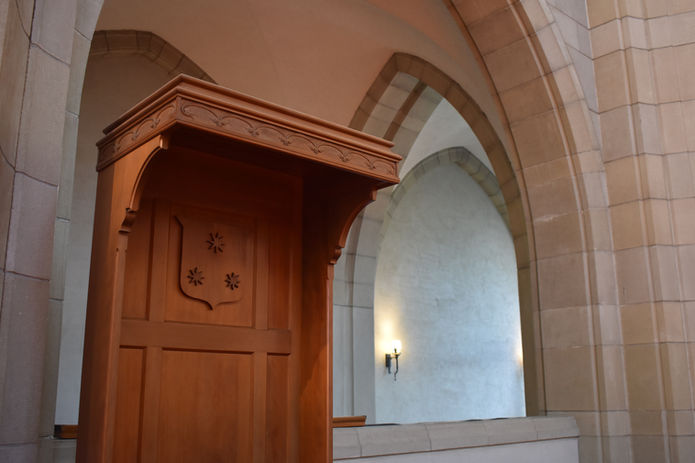
— HOLY TRINITY CATHEDRAL CHANCEL
The Chancel is the oldest part of Holy Trinity Cathedral and is used primarily for the service is Evensong. The pews and choir stalls face inwards echoing the quires of European cathedrals.
The foundation stone for the Cathedral was laid in 1957. The Chancel, built in a neo-Gothic style was completed in 1973 and served as the Cathedral for over twenty years until the completion of the Cathedral Nave in 1995.
THE HIGH ALTAR AND SANCTUARY
Our Cathedral reflects the Three Tikanga Church of the Province of Aotearoa, New Zealand and Polynesia. In addition to the cathedra, the seat of the Bishop of Auckland, we also have seats for Tikanga Māori, Tikanga Pasifika, each with their own unique crest. The chairs are kept in the Chancel sanctuary when not in use.
The high altar was designed by Malcolm Mckenzie and has been built out of kauri from the old St Mary’s Hall.
The central cross is made of kauri and is gilt edged with crowns at the extremities of the crossbars. The use of widening and narrowing of the width of the material makes the twelve-foot Cross look rather slender and light.
The reredos is erected over the cross. The design is intended to incorporate the panels as seen in the Altar and in the stonework in the front of the balcony overlooking the transept. The coloured lighting on the back wall reflects the liturgical seasons and changes between several colours throughout the year.
The altar, the candlesticks, the reredos, the pews, the carpet, the cross and the altar rails were all financed by donations. The choir stalls were especially designed for the Holy Trinity Cathedral Choir who raised the money themselves through recording sales.
THE ROSE WINDOW
A generous anonymous gift in memory of the Pioneers of our land, over 5 metres in diameter (17 ft). The glass was designed and made by Carl Edwards of London. The design is a symbolic representation of the Holy Trinity, under which name the Cathedral is dedicated. The main element of the design consists of an EYE, in the top segment – the mediaeval symbol of God the Father; a RUBY CROSS running right through – a symbol of God the Son; and a DOVE in the centre – symbolizing God the Holy Spirit. The dove is seen “moving upon the face of the waters” – illustrating the theme of Creation.
Within the inner circle of tracery there are seven Crowns symbolizing the seven Gifts of the Holy Spirit. The outer ring of tracery contains the symbols of the Lion (St Mark); the eagle (St John); the Angel (St Mathew); the Ox (St Luke). Also included in the outer ring are Alpha (α) and Omega (ω) – God the Beginning and the End.
THE CANTERBURY CROSS
Mounted on the right-hand pillar near the foot of the Chancel is the Canterbury Cross. This is one of twelve replicas of the original Canterbury Cross referring to the twelve Apostles. The replicas were cast in bronze and mounted on pieces of stone from Canterbury Cathedral then sent around the world to twelve other Anglican Cathedrals and a visible reminder of the link with the Mother Church in Canterbury.
The design of the Canterbury Cross shows it to be an early Consecration Cross. This cruciform is also known as Becket’s Cross, after one of the more famous Archbishops of Canterbury.







